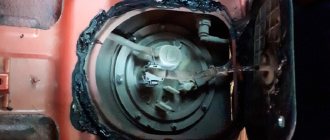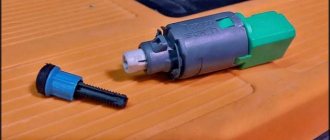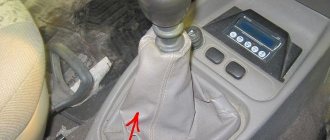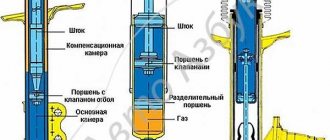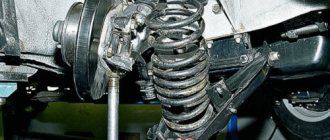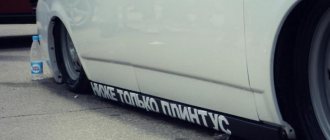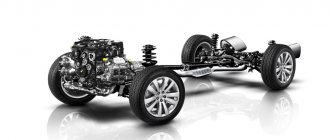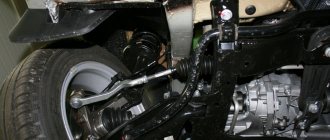The quality and technical features of the suspension are a very important detail for any car, including the Lada Vesta. The stabilization system feature, as well as other innovations in the suspension of the new sedan, became a real sensation for the Russian automobile industry.
In the process of creating the car, the developers had a goal - to create a design that is relevant for Russian roads on a platform that is not inferior in reliability and functionality to the best foreign models. The suspension for the Lada Vesta turned out to be a truly unique creation, created by Russian specialists.
Front Features
The front part of the Lada suspension has taken on the maximum of innovations. Let's look at these features in more detail.
The drawing below shows the front suspension of the Lada Vesta. As you can see, its supporting base is a subframe. By changing the design, it unloads the metal of the body, and at the same time participates in the distribution of force after passing through irregularities. The steering rack, anti-roll bar attachment points, and lower arms were moved to the subframe.
Diagram and design of the front suspension:
- Additional subframe spar;
- Front suspension subframe;
- Lower front suspension arm;
- Steering knuckle with hub assembly;
- Telescopic front suspension strut assembly;
- Anti-roll bar with struts assembly
Vesta front suspension features:
- The concept of architecture has changed; the structure is assembled on a subframe. Thanks to this, rigidity indicators were increased, geometry accuracy increased, and vibration-acoustic properties were improved.
- The steering rack is now located at the bottom, thanks to which the wheel rods are directly connected to the hubs. This made it possible to improve the handling of the Lada and achieve real competitiveness in relation to foreign models;
- The castor angle is 5 degrees, the suspension is independent. MacPherson struts are used. There is a new stabilizer. The system is more sensitive than on previous models and provides smoother control.
The anti-roll bar has also been upgraded. The torsion bar has acquired a more advanced shape and is now equipped with long struts. This significantly improved the handling of the Lada.
Photo of the front:
The front suspension is maximally adapted to Russian roads and allows the Lada Vesta to confidently perform in any situation.
According to the owners' reviews, the car's chassis is made to last, Vesta walks on the road very smoothly and even outperforms foreign competitors such as Hyundai Solaris and KIA Rio.
Lada Vesta front suspension design
The supporting structure is based on a subframe, which is an innovation for the domestic automobile industry. Also, for the first time, the L-shaped levers were used.
The subframe performs the additional function of strengthening the body, giving it strength, and preventing deformation on uneven surfaces. As a result, the overall safety score was increased by five points.
In general, the suspension design is quite simple and in many ways similar to Renault Logan and Renault Duster of the second generation. Carrying out preventive maintenance does not require additional costs. The steering gear is now secured to the bottom of the engine compartment.
Independent suspension
From a physical point of view, the “low” position of the rack provides maximum connection with the steering knuckle. An electric amplifier is pre-installed on the rail, which was not previously in the design of VAZs. The shape of the transverse stabilizer has been redesigned to improve the “feel” when turning the steering wheel. The castor (tilt) angle is 5°, independent suspension, MacPherson struts, which together make the car smoother.
Rear suspension
In order to give an objective assessment of the chassis of the Lada Vesta, we study the suspension of the rear of the car. Everything is simpler here, everything is done according to the classical scheme. But there are a few innovations that have been built into the rear. What you see is a new arrangement: barrel-shaped coil springs are mounted on a transverse beam with spaced shock absorbers and brake drums.
Rear suspension diagram:
- Rear suspension arms;
- Lower spring gasket;
- Rear suspension spring;
- Upper spring gasket;
- Upper support assembly;
- Compression stroke buffer with protective casing assembly;
- Rear suspension shock absorber;
- Rear wheel hub axle;
- Brake drum with rear wheel hub bearing assembly
Let's look at the changes in more detail:
- Springs and struts are now arranged in a new, spaced-out way, and this is a serious step forward for Lada and for the entire Russian automobile industry;
- The suspension was tuned at the Renault plant using European technologies;
- It is worth noting that the rear track on Vesta was expanded to 1510 millimeters, due to which the rear wheel arches were enlarged.
We can conclude that Vesta’s body is equipped with a modern rear suspension, which means that now passenger comfort and a smooth ride will become integral qualities of the new Russian car.
PS
According to real reviews from Lada Vesta owners, some experience creaking and extraneous noise in the rear suspension. The squeak may be due to a lack of lubrication of the bushings - the problem is easily solved, go to the dealer or service station, they will lubricate the bushings and the squeak will disappear. You need to look at the noise, a possible solution to the problem would be to install washers on the shock absorbers. More details below, in the section Reviews and faults
What's new: about built-in technologies and stabilization system
In addition to the Vesta features listed above, it is worth considering a number of other innovations in the chassis, which are no less important. First of all, it is necessary to note the use of systems such as ABS, ESP, and EBD. In addition, the Lada Vesta has power steering from Nissan, and its braking system is equipped with components from Renault Logan and Renault Megane. Acting together, these factors give the car high status and reliability.
The new Lada Vesta has a built-in stabilization and traction control system. The system allows you to easily overcome various skids and drifts of the car while driving.
When the electronics in a car are correctly and professionally configured and are capable of simulating a differential lock, then the vehicle’s cross-country ability significantly improves. The Lada Vesta has just such a system and it is configured really effectively. Now you don’t have to worry about getting into mud, snow, uneven surfaces, or driving off to the side of the road. When the stabilization system is turned on, the Lada goes into all-terrain mode and is able to get out of a difficult situation.
This technology is being used for the first time and, judging by real reviews from car owners, it actually works well and does not fail in difficult conditions.
Reviews
| № | Positive |
| 1. | Dmitry Vasilyevich , 43 years old (otzovik.com): the suspension is mounted on a subframe, a new form of levers, steering knuckles. Road obstacles are overcome without impact. |
| 2. | Arkady Semenovich , 39 years old (www.zr.ru): there are no complaints about the suspension at speeds up to 120 – 130 km/h, it works quickly and softly. At higher modes, there is a decrease in control efficiency, the car rolls when entering turns. |
| 3. | Kirill , 22 years old (autobann.su): control is sharp due to the fact that the rack is pre-installed on the subframe and has an indirect connection with the steering knuckles. |
| 4. | Matvey , 33 years old (lada-vesta.net): on previous modifications of the Lada, the chassis, suspension, and steering mechanism were worse. I can compare, since before the Lada Vesta there was a Priora and a Granta. |
| 5. | Vasily Petrovich , 43 years old (otzovik.com): my positive review of the chassis and suspension of the Lada Vesta. I've been using the car for three years now, no complaints. |
| 6. | Pyotr Semenovich , 45 years old (www.zr.ru): for me, as a resident of a rural area, you can’t find a better car. I'm happy with the purchase, no complaints. I fix minor breakdowns on my own without going to a service station. |
| 7. | Sergey , 20 years old (autobann.su): rear springs and shock absorbers have become softer compared to the Lada Granta. Minor unevenness is silently absorbed. For our imperfect roads, this is what we need. |
| 8. | Saveliy Petrovich , 43 years old (lada-vesta.net): the vehicle’s ground clearance allows it to overcome many obstacles without reducing speed, detours, or maneuvers. This is very good for city roads when the car follows the flow. |
| 9. | Dmitry , 30 years old (otzovik.com): my positive review of the Lada Vesta, there are no critical comments, and I fix minor breakdowns on my own. |
| 10. | Nikolai Petrovich , 43 years old (www.zr.ru): there are no comments on the components, I systematically carry out technical inspections, diagnostics, and treat equipment with care. The car is three years old, the condition of a new car. |
| 11. | Alexey , 35 years old (autobann.su): replaced the bushings in two years, checked the wheel alignment. I'm pleased with the build quality, my recommendations to motorists. |
| Negative | |
| 12. | Vitaly Nikolaevich , 43 years old (www.zr.ru): in the first year of service, replaced the chassis bushings. The shock absorbers began to leak and the springs began to creak. |
| 13. | Leonid , 27 years old (otzovik.com): after 35,000 km, replaced the standard stabilizer seals with polyurethane ones. The manufacturer saves on materials and installs the cheapest ones. |
| 14. | Arsen Mikhailovich , 45 years old (autobann.su): the model needs to be improved and defects eliminated. It’s better to wait a while or buy a second generation Renault Logan. |
Differences between the Lada Vesta sedan suspension and SW and SW Cross
In fact, the suspension of the Vesta sedan and station wagon is similar; they have the same wheelbase. But given that the Lada Vesta SV has increased body dimensions, the settings for this part are slightly different.
Also, with a similar design base, the SW Cross has some differences - it has original springs and is equipped with 17″ wheels. Due to this, the ground clearance is increased to 203 mm. In addition, Vesta Cross is equipped with disc brakes and the track width has been increased by 25 mm. That's basically all the differences.
Reviews and detected malfunctions in the suspension
Enough time has passed since the release of the production Lada Vesta for drivers to evaluate the handling and operation of the car’s mechanisms. Based on reviews from Vesta owners, we can conclude that innovations in the design have improved the quality of vehicle handling and passenger comfort.
However, there are also negative reviews, mainly related to the appearance of extraneous noise in the rear suspension during operation. To solve this problem and eliminate noise, experts suggest installing gaskets on the rear shock absorbers. Knocking and squeaking noises can be caused by a lack of lubrication in the bushings or if the rear shock absorber is missing a washer.
How to identify a problem in your car
To identify problems, you need to hang the car so that the front wheels do not touch the surface. By moving the wheel in both planes, we determine the play and the corresponding malfunction:
- If the brake pedal is released and you feel play, there is wear on the front wheel bearing.
- If play is felt when the brake pedal is pressed and released, there is a suspension malfunction,
- If you feel play in the vertical plane, then either the strut is poorly secured or the ball joint is worn out,
- If there is play in the horizontal plane, there is a problem with the front suspension module, namely the tie rod end.
And here’s an additional bonus for you - wheel alignment angles for the Lada Vesta:
Conclusion
After studying the numerous innovations that were used in the manufacture of the suspension, we can conclude that AvtoVAZ took the creation of the Lada Vesta very seriously. It's clear that close attention has been paid to more than just the engine and design. Creating a high-quality design and giving the car excellent driving characteristics indicates that the company cares about its reputation and thinks about its customers. The new stabilization system allows Vesta’s suspension to be considered revolutionary in the Russian automobile industry.
Effective innovations
When designing Vesta Cross pendants, VAZ manufacturers also used modern electronic systems, among which are:
A stabilization system has been introduced into the vehicle. With its help, the likelihood of vehicle demolition is reduced, as well as skidding when moving outside the city and along difficult routes. With the help of the stabilization system, control is exercised over various components and elements, traction.
If the suspension on a Vesta car is combined with an electronic system, then an imitation of the main differential locking occurs. As a result, off-road travel is easy. After all, the cross-country ability of vehicles improves significantly. The same advantage was noted by other drivers who reviewed it.
